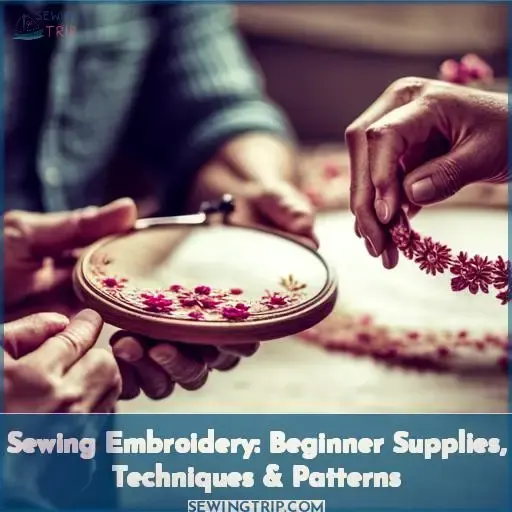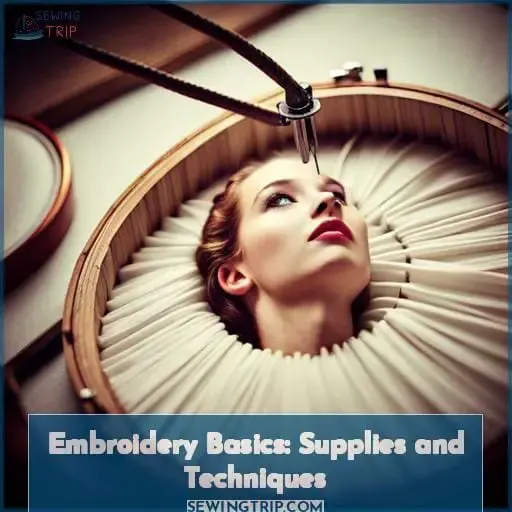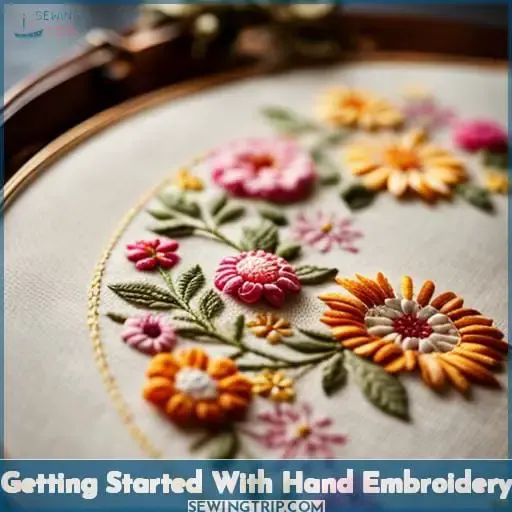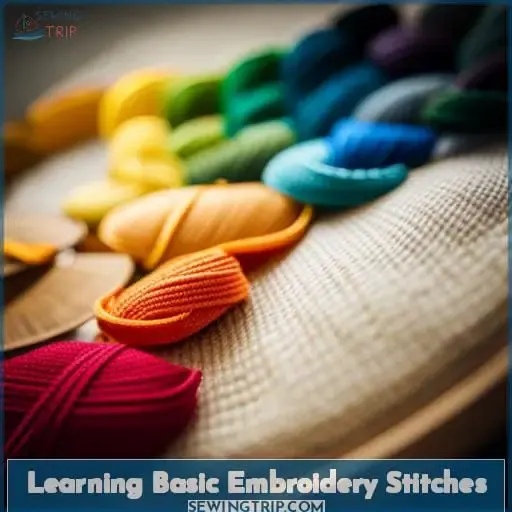This site is supported by our readers. We may earn a commission, at no cost to you, if you purchase through links.
 Imagine yourself sitting down at your sewing machine, ready to embark on a new creative adventure. With just a few simple supplies and the right techniques, you can bring life and beauty to any fabric through the art of sewing embroidery.
Imagine yourself sitting down at your sewing machine, ready to embark on a new creative adventure. With just a few simple supplies and the right techniques, you can bring life and beauty to any fabric through the art of sewing embroidery.
In this article, we will guide you through the beginner’s journey of sewing embroidery – from choosing supplies to mastering basic stitches and exploring unique patterns.
Table Of Contents
Key Takeaways
- Gather essential supplies: fabric, needles, thread, embroidery hoop, and tracing tools.
- Focus on thread management for smooth stitching.
- Master needle management with the right size and type.
- Choose needle-penetrable fabrics like cotton or linen.
Embroidery Basics: Supplies and Techniques
Let’s begin by discussing the three main lessons that will lay a strong foundation for your embroidery journey.
In Lesson 1, we’ll focus on gathering the beginner supplies you’ll need to get started.
Lesson 2 is all about essential techniques for beginners, where we break down each stitch step-by-step so you can easily grasp them.
And in Lesson 3, we’ll share some valuable tips and tricks to ensure successful and enjoyable embroidery sessions.
Lesson 1: Beginner Supplies
First, gather the necessary supplies for your embroidery journey.
The essential tools include fabric, needles, thread, an embroidery hoop, and tracing tools.
Choosing the right fabric is crucial for a successful project – opt for needle-penetrable fabrics that suit your design.
Thread management is key to neat and tidy stitches – learn how to handle threads effectively.
Finally, get creative with embellishments to add unique touches to your embroidery pieces.
Mastering hoop techniques will ensure smooth stitching experiences as you embark on this exciting beginner’s lesson in sewing embroidery!
Lesson 2: Essential Techniques for Beginners
In this lesson, you’ll learn essential techniques to help you get started with embroidery.
Here are some key points to remember:
- Master thread management for smooth stitching.
- Learn different starting techniques for your stitches.
- Improve your needle handling skills for precision and control.
- Explore various stitch variations to add depth and texture to your designs.
- Troubleshooting tips will help you overcome common challenges in embroidery.
Get ready to level up your embroidery skills!
Lesson 3: Tips and Tricks for Successful Embroidery
To achieve successful embroidery, it’s important for you to implement a variety of tips and tricks that will enhance your stitching skills and overall experience.
Master needle management by selecting the right size and type of needle for your fabric.
Explore different thread techniques to add texture and dimension to your designs.
Perfect your patterns by practicing precision in tracing or transferring them onto fabric.
Achieve hoop harmony by properly securing your fabric in the embroidery hoop for smooth stitching.
And don’t forget the finishing flourish – learn techniques to neatly finish off your embroidery projects for a polished look.
Getting Started With Hand Embroidery
Now that you have a good understanding of the basics and have gathered your essential supplies, it’s time to get started with hand embroidery.
In Lesson 4, we’ll explore how to choose the right fabric for your project.
In Lesson 5, we’ll cover transferring patterns onto fabric.
Finally, in Lesson 6, you’ll find beginner embroidery patterns to practice your newly acquired skills.
Let’s begin this exciting journey into the art of hand embroidery!
Lesson 4: Choosing the Right Fabric
When starting out with hand embroidery, it’s important for you to choose the right fabric that’s suitable for needle penetration and will enhance your stitching experience.
Look for fabrics that are easily penetrable by a needle, such as cotton or linen. These fabrics offer advantages like smoothness and durability, ensuring your stitches hold up over time.
Choosing wisely will make a difference in the quality of your embroidery work and allow you to create beautiful textile art while enjoying the process.
Lesson 5: Transferring Patterns Onto Fabric
Before you begin embroidering, it’s important to know how to transfer patterns onto your fabric.
In Lesson 5, we’ll explore various transfer techniques that allow you to bring your chosen embroidery pattern onto the fabric surface.
From using carbon paper and tracing tools to iron-on transfers and water-soluble pens, there are many options available for transferring patterns with ease.
We’ll also discuss troubleshooting tips for when things don’t go as planned and creative transfers for adding artistic flair to your embroidery projects.
Lesson 6: Beginner Embroidery Patterns
Looking to get started with hand embroidery? Wondering where to find beginner embroidery patterns? Here are four ways to explore and discover exciting patterns for your embroidery projects:
-
Pattern Exploration
- Dive into online resources, books, and magazines dedicated to embroidery designs.
- Discover a vast collection of patterns suitable for beginners.
-
Design Inspiration
- Take inspiration from nature, art, or everyday objects around you.
- Let your creativity flow as you adapt these inspirations into unique embroidered designs.
-
Stitch Combinations
- Experiment with different stitch combinations to create texture and dimension in your embroideries.
- Mix and match stitches like satin stitch, French knots, or backstitch for stunning effects.
-
Creative Variations
- Add a personal touch by modifying existing patterns or creating your own variations on classic motifs.
- Explore color choices, thread weights,and embellishments that make each piece uniquely yours.
Learning Basic Embroidery Stitches
Now that you have a solid foundation in embroidery, it’s time to master the basic stitches.
In Lesson 7, we’ll focus on essential stitches such as the running stitch and backstitch.
Once you feel comfortable with these foundational stitches, move on to Lesson 8 where we explore other beginner-friendly embroidery stitches like the chain stitch and lazy daisy stitch.
Finally, in Lesson 9, we’ll delve into some uncommon but beautiful embroidery stitches that will take your skills to the next level.
Get ready for an exciting journey of learning and expanding your stitching repertoire!
Lesson 7: Mastering Basic Stitches
Start by mastering the basic embroidery stitches with this comprehensive lesson.
Practice techniques that will help you perfect your split stitch, satin stitch, backstitch, and couching stitch.
Explore variations of these stitches to add creativity to your projects.
Troubleshooting tips are included for any challenges you may encounter along the way.
Discover how to integrate these stitches into different patterns and unleash your creativity in various creative applications using the embroidery stitch bible as a valuable resource.
Lesson 8: Exploring Other Embroidery Stitches for Beginners
To expand your embroidery skills as a beginner, delve into exploring other basic embroidery stitches.
Here are some stitch variations to help you unleash your creativity and add unique touches to your projects:
- Creative Embellishments:
- Experiment with decorative stitches like the woven wheel stitch or bullion knot rose for beautiful floral designs.
- Unusual Stitch Techniques:
- Try out uncommon stitching techniques such as the threaded running stitch or whipped backstitch for intriguing textures.
- Experimental Stitching:
- Fuse different stitches together to create interesting combinations and patterns that showcase your individual style.
With these ideas in mind, you’ll be able to take your embroidery projects to new heights of artistry!
Lesson 9: Uncommon Embroidery Stitches
Explore uncommon embroidery stitches to expand your repertoire and add unique flair to your creations.
Delve into the world of knot mastery with techniques like the bullion knot, which creates beautiful three-dimensional effects.
Discover threaded elegance by incorporating stitches like the couching stitch, where a thicker thread is laid on top of the fabric and secured with small stitches.
Whip up wonders with techniques such as whipped backstitch for added texture and visual interest.
Embellish your designs with rose motifs using intricate stitching techniques that will leave you in awe of their beauty.
Frequently Asked Questions (FAQs)
How do I choose the right fabric for my embroidery project?
To choose the perfect fabric for your embroidery project, consider needle-penetrable options that suit your design. Explore different fabrics and their advantages to enhance your stitching experience and create beautiful masterpieces with ease.
What are some common mistakes to avoid when starting embroidery?
When starting embroidery, avoid common mistakes:
- Using the wrong fabric
- Not securing your stitches
Did you know that over 300 embroidery stitches exist, offering endless possibilities for creativity and mastery?
Can I use regular sewing thread for embroidery?
Yes, you can use regular sewing thread for embroidery. However, it may not give you the same results as embroidery-specific thread. Experiment with different threads to achieve the desired effect in your stitching.
How do I transfer a pattern onto fabric for embroidery?
To transfer a pattern onto fabric for embroidery, unleash your creative spirit and wield the power of tracing tools.
Let your design dance from paper to cloth with delightful precision, igniting a spark of mastery in every stitch.
What are some tips for properly caring for and preserving hand-embroidered pieces?
To properly care for your hand-embroidered pieces:
- Gently hand wash them with mild soap and cold water.
- Gently press out excess moisture using a clean towel.
- Iron on the reverse side while still slightly damp to maintain their shape and vibrancy.
Conclusion
To sum it up, sewing embroidery is a captivating art form that allows you to transform plain fabric into extraordinary works of art.
By following the lessons outlined in this article, you can confidently dive into the world of embroidery and create stunning pieces using basic supplies and techniques.
Whether you choose to explore hand embroidery or experiment with different stitches, the possibilities are endless.
So grab your sewing machine, thread, and fabric, and let your creativity soar as you embark on your sewing embroidery journey.
Happy stitching!









